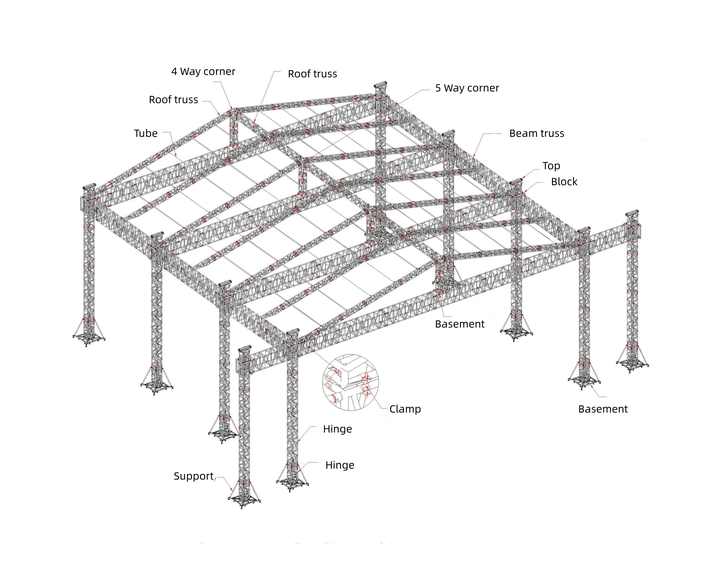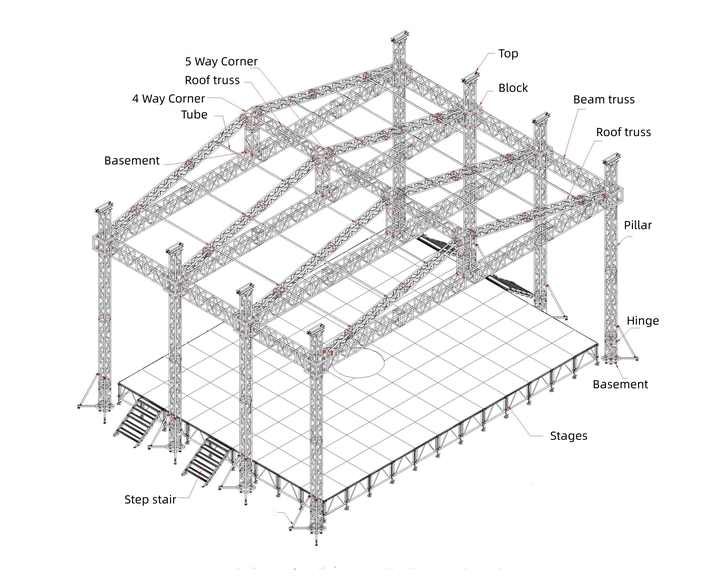What Are You Looking For?
The modern concert experience is a meticulously orchestrated spectacle, a harmonious blend of visual artistry and auditory immersion. Central to this spectacle is the stage, a dynamic platform where lighting design and sound engineering converge to create an unforgettable performance. At the heart of this stage infrastructure lies the increasingly prevalent aluminum stage lighting truss, often integrated with line array wings, forming a robust and versatile system capable of supporting complex lighting rigs and high-powered speaker systems for large-scale concert events.
Aluminum's lightweight yet high-strength properties make it the material of choice for stage trussing. Its inherent malleability allows for intricate designs, facilitating the creation of complex configurations tailored to the specific needs of individual performances. Unlike steel, aluminum resists rust and corrosion, ensuring longevity and minimizing maintenance requirements, especially crucial in outdoor or environmentally challenging venues. The modular nature of aluminum trussing allows for quick and efficient assembly and disassembly, a vital factor considering the time constraints often associated with concert setup and teardown. Standard connections, utilizing bolts or pins, ensure ease of handling and facilitate adaptability to varying stage dimensions and layouts.

The integration of line array wings directly into the truss structure enhances both the aesthetic and functional aspects of the stage setup. Line arrays, characterized by their vertical arrangement of multiple loudspeaker elements, offer superior sound dispersion and coverage, particularly beneficial in large venues where achieving uniform sound distribution is paramount. Integrating these arrays into the truss system streamlines the rigging process, reducing the number of separate support structures and simplifying cable management. This streamlined approach contributes to a cleaner, more professional appearance, while also enhancing safety by minimizing potential hazards associated with independent rigging systems.
The design of the truss and wing system is crucial for ensuring structural integrity and stability under load. Careful consideration must be given to the weight capacity of the truss sections, the distribution of weight across the entire structure, and the wind load calculations, especially for outdoor concerts. Engineering specifications, including material thickness, connection points, and bracing elements, must adhere to relevant safety standards and regulations to guarantee the safety of performers, crew members, and the audience. Professional structural engineers are often consulted to design and verify the stability of these complex systems, ensuring that the structure can safely support the weight of the lighting fixtures, speakers, and other equipment.

Beyond the structural aspects, the aesthetic contribution of the truss and line array wings is undeniable. The truss itself can be used as a design element, incorporating creative lighting effects and projections that enhance the visual spectacle of the performance. The clean lines and uniform structure provide a backdrop that can be tailored to complement the overall stage design, from minimalistic elegance to elaborate visual complexity. Furthermore, the integration of the line array speakers into the truss system enhances the visual impact of the sound system, creating a cohesive and visually striking stage presence.
However, the implementation of such systems also presents logistical challenges. Transportation and storage of the sizable truss and wing components require specialized vehicles and warehousing, adding to the overall costs of the production. The assembly and dismantling process necessitates skilled and experienced riggers, adding to labor costs. The intricate nature of the system also demands meticulous planning and coordination to avoid errors and ensure safety. Thorough risk assessments and comprehensive safety protocols are essential throughout the entire process, from initial design to final teardown.
In conclusion, aluminum stage lighting truss with integrated line array wings represents a significant advancement in stage infrastructure for concert events. This combination offers a robust, versatile, and aesthetically pleasing solution for supporting complex lighting and sound systems, creating a truly immersive and unforgettable experience for both performers and audiences. However, effective utilization requires careful planning, adherence to safety regulations, and the expertise of skilled professionals to ensure a seamless and successful event. The careful balance between structural integrity, aesthetic appeal, and logistical considerations ultimately determines the success of incorporating this sophisticated system into a concert production.